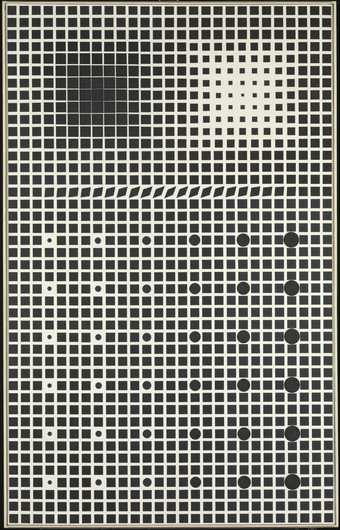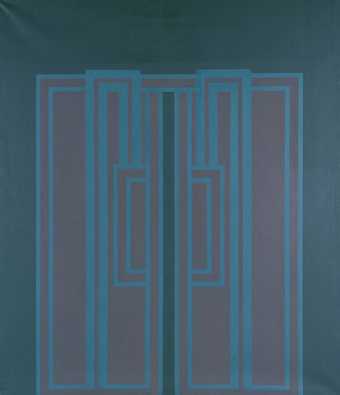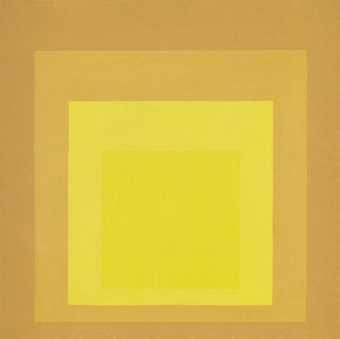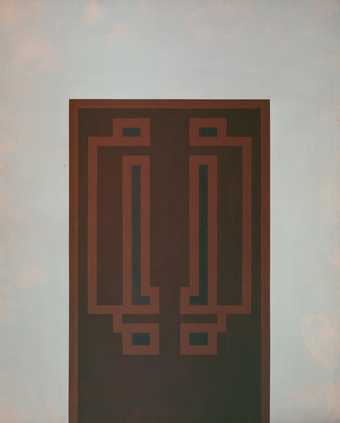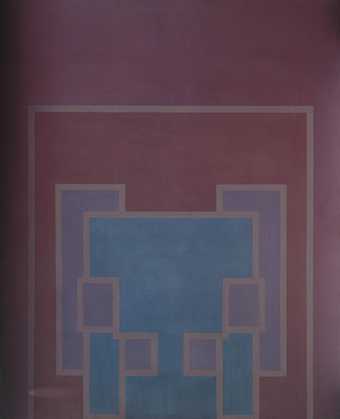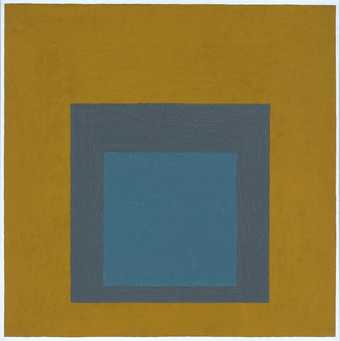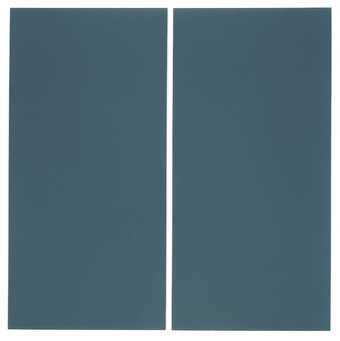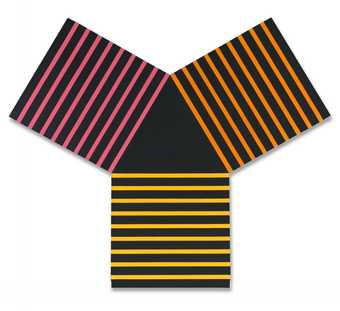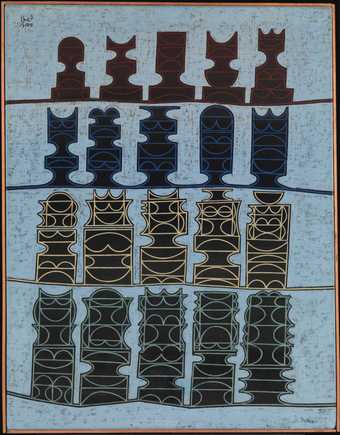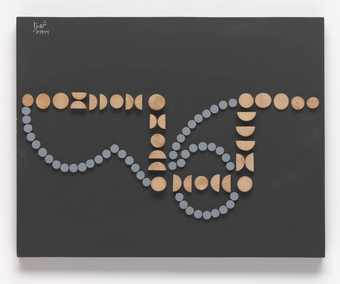
Not on display
- Artist
- Anwar Jalal Shemza 1928–1985
- Medium
- Oil paint on canvas
- Dimensions
- Support: 915 × 915 mm
- Collection
- Tate
- Acquisition
- Purchased 2012
- Reference
- T13567
Summary
Meem Two 1967 is an oil painting by the artist Anwar Jala Shemza. The work has a stylised, symmetrical composition centred on the Arabic letter meem (or ‘m’). The letter is painted four times in navy blue lines, twice originating from the centre and moving towards the bottom of the painting, and twice originating from the centre and moving towards the top of the painting. The circular forms of the letter meem are joined neatly in the middle of the composition and their round forms are accentuated by bright orange and pale green paint which is applied precisely in the cores and the negative spaces created by the letters. A shade of dark grey is applied to the area bordered by the letters, creating an overall phallic shape that is set against a lighter grey background.
Much of Shemza’s practice is founded on the basics of geometry. This influence can be linked to his early exposure to traditional Indian carpet designs from his family business, but also more directly to Islamic design and Mughal architecture. Many of his works explore the relationship between basic geometrical shapes, such as the circle and the square. He stated: ‘A circle – a square – a puzzle – for which a lifetime is not enough.’ (Quoted in Dadi 2009, p.3.) The combination and the amalgamation of these two shapes provided infinitely flexible configurations that also brought him close to Arabic and Persian calligraphy. This interest can be observed in both Chessmen One 1961 (Tate T13333) and Forms Emerging (Tate P79950), where the circle and square are deconstructed and reconfigured into a series of repeated and recognisable shapes. In Meem Two the visual motifs of calligraphy are translated into a formalist observation of geometric forms, breaking away from the ornate and decorative nature of the calligraphic line. This also diverts from the religious connotations of the painting, as the letter meem refers to the initial of the prophet Mohammad.
Shemza also makes direct reference to calligraphy in examining the relationship between visual and textual practice. At the back of one of his notebooks he wrote: ‘My work is based on the simplification of the three dimensional solid, architectural reality of the decorative element of calligraphy … “Calligraphy” which gives means to convey your feelings and also produce some aesthetic response … As Mondrian says, “I think the destructive element is too much neglected in art”.’ (Quoted in Shemza 1989, p.71.) Shemza always started his working process by making drawings in his sketchbooks. His works were meticulously planned out and he would make notes in Urdu and English about the development of particular pieces, tracing how he would realise and finish them. Peter Burnhill, who was on the staff at Stafford College of Art and Design where Shemza also taught from 1962 onwards, wrote of Shemza’s practice:
Shemza’s sketchbooks show very clearly his primary interest – obsession, almost – with linear, rhythmically orchestrated and serially developed two-dimensional space, stored in the head and brought out in the very act of drawing rather than developed from observation. Page after page of his sketchbooks are covered with serial developments of black and white drawing from which he could select and later develop paintings in colour.
(Quoted in Shemza 1989, p.73.)
Meem Two is part of a series of Meem paintings which Shemza began in 1967 and of which there are six in total. They are characterised by groups of orange discs that consist of the core of the letter meem, as evidenced in Meem Two, in different compositions. This painting was exhibited at Overy Mill Gallery, Dorchester-on-Thames around 1970, in East Comes West at Bradford City Art Gallery and Museum in 1971, in The Other Story at the Hayward Gallery, London in 1989–90 and in Shemza’s retrospective exhibition at Birmingham City Art Gallery in 1997–8.
Shemza was born in Simla, India in 1928 and studied at Lahore Mayo School of Art in Pakistan (1943–6) before moving to London in 1956 to study at the Slade School of Art. He taught for a short while when he was living in Lahore, which is what prompted him to come to London and experience European Art education with the hopes of teaching more effectively upon his planned return to Pakistan. However, his plans changed and he eventually settled in Stafford in 1962 where he took up a teaching job and remained until his death in 1985. Shemza’s years at the Slade were some of the most fundamental of his artistic development. His displacement allowed him to confront and question his previous practice, which was characterised predominantly by figurative and illustrative compositions. In London his work developed towards an abstraction that fused Islamic motifs and calligraphic forms with western abstraction.
Further reading
Mary Shemza, ‘Anwar Jalal Shemza: Search for Cultural Identity’, Third Text, vol.3, nos.8 and 9, 1989, pp.65–87.
Iftihar Dadi, Perspectives 1 – Anwar Jalal Shemza: Calligraphic Modernism, London 2009.
Rachel Garfield, Perspectives 2 – Anwar Jalal Shemza: The British Landscape, London 2010.
Leyla Fakhr
January 2011
Does this text contain inaccurate information or language that you feel we should improve or change? We would like to hear from you.
Display caption
Shemza started the Meem series in 1967 as part of an ongoing exploration of calligraphic abstraction. In these works Shemza reconfigures the Arabic letter ‘Meem’ into powerful variations displaying great symmetry and rhythm. The ‘Meem’ refers to the initial letter of the prophet Mohammad so has a religious reference, but as the initial of his wife Mary’s first name, it has emotional significance. At the back of one of his notebooks, Shemza expresses: ‘My work is based on the simplification of three dimensional solid, architectural reality of the decorative element of calligraphy… Calligraphy which gives means to convey your feelings and also produce some aesthetic response.’
Gallery label, October 2015
Does this text contain inaccurate information or language that you feel we should improve or change? We would like to hear from you.
Explore
- abstraction(8,615)
-
- non-representational(6,161)
-
- geometric(3,072)
- formal qualities(12,454)
-
- symmetry(220)
You might like
-
Victor Vasarely Supernovae
1959–61 -
Robyn Denny Life Line I
1963 -
Josef Albers Study for Homage to the Square: Departing in Yellow
1964 -
Robyn Denny First Light
1965–6 -
Robyn Denny Garden
1966–7 -
Josef Albers Study for Homage to the Square: Beaming
1963 -
Josef Albers Study for Homage to the Square
1963 -
Josef Albers Study for Homage to the Square
1964 -
Alan Charlton 2 Part Vertical Painting
1991 -
Josef Albers Homage to the Square: Study for Nocturne
1951 -
Jeremy Moon Arabian Night
1967 -
Anwar Jalal Shemza Chessmen One
1961 -
Anwar Jalal Shemza Composition with Number Six
1966 -
Saloua Raouda Choucair Composition with Two Ovals
1951 -
Anwar Jalal Shemza Composition in Red and Green, Squares and Circles
1963

